Soviet main wheeled APC
The BTR-60P was already a well-capable and mass-produced vehicle, but the Soviet Army needed a successor to this vehicle, and development started at GAZ (already in charge of the BTR-60) in 1965-66 to provide it. It was to have a lower profile, better tires, be faster and to be better protected while keeping the maximal compatibility with the former in order to simplify mass production. The BTR-60/70/80/90 family is now an unmistakable landmark in the history of APCs, being one of the first height-wheeled amphibious vehicle developed in the east, and which proven rugged and adaptable to countless uses. This line of vehicles was sold by the thousands, built under license or inspired local productions in Romania, West Germany, Poland, Czechoslovakia, China and North Korea.Development
The BTR-70 came out first as the industrial prototype GAZ-4905 and was closesly based on the BTR-60PB in 1967-68, most of the changes been applied to the hull. It was tested for two years before being accepted for production in 1970, and for service on August 21, 1972, hence the BTR (which stands for "Bronetransportyor") "70" before of the decade. In reality most were delivered in the 1980s.Design
Hull
Although still very close to the original design, with the same internal configuration (driver at the front, crew compartment in the middle, engine at the rear), the BTR-70 had a sleeker profile, sowewhat less bulky. It was much longer (7.86 instead of 7.56 m), narrower (3 cm) and taller (1 cm), the BTR-70 was also heavier (11.5 tons vs 10.3 tons on the BTR-70PB) although part of this weight was due to bigger engines. The all-welded hull was made of RHA, fully waterproof. In this respect, the BTR-70 was like its predecessor, capable of swimming with minimal preparation (erection of the front trim vane and bilge pumps switched on). Some effort was put on the protection which better armour plating although its thickness remained unchanged at 10 mm front, 7 mm sides and rear and 5 mm elsewhere. This provided some cover from front against heavy machine guns, and small arms fire although the folded trim vane and possible addition of welded plates on the front beak could provide extra protection.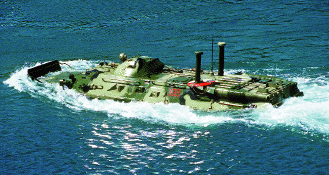 The BTR-70 swimming.
But the major change was the exit door configuration for the troops. Instead of upper hull sides lateral doors, these were moved to the lower section of the hull (below the beltline), right between the two pairs of roadwheels which were much far apart than on the BTR-60 and justified the longer hull. This provided an easier access inside the vehicle and secured at least in theory any exit while on the move, the soldiers keeping a lower profile, being less exposed to enemy fire. The main drawback of course was revealed in exercizes, unexperienced or unlucky infantrymen being pulled under a wheel and injured or killed.
The BTR-70 swimming.
But the major change was the exit door configuration for the troops. Instead of upper hull sides lateral doors, these were moved to the lower section of the hull (below the beltline), right between the two pairs of roadwheels which were much far apart than on the BTR-60 and justified the longer hull. This provided an easier access inside the vehicle and secured at least in theory any exit while on the move, the soldiers keeping a lower profile, being less exposed to enemy fire. The main drawback of course was revealed in exercizes, unexperienced or unlucky infantrymen being pulled under a wheel and injured or killed.
Performances
The supplementary weight of the vehicle was at first coped with a pair of 115 hp GAZ-69B 6-cylinder engines, and later compensated by a much better engine, a couple of ZMZ-49-05 gasoline engines which gave an output of 120 hp (88.2 kW) each, and a Power/weight of 20 hp/tonne. This was 240 hp combined, compared to the 180 hp of the previous serie, which seemed underpowered in comparison. However despite this surge in power, performances were similar: It could reach 80 km/h on flat, and swim to 9 km/h thanks to a rear hull single water jet. Operational range was roughly also the same at 400 to 600 km.Armament
The main armament was based on the PB, with a fully traversible conical turret which can house either a 12.7 mm DsHk or the heavier 14.5 mm KPVT heavy machine gun (500 rounds) with enough elevation (30°) to fire against low-fyling targets, especially helicopters. Its practical range was 2000 against ground targets and 1400 in AA configuration. The rate of fire was 80 rpm sustain and up to 600 in short bursts. There was also a coaxial 7.5 mm PKT light machine gun with 2000 rounds inside the turret, which had a similar -5/+30 depression/elevation and could fire tracers. There was also an onboard storage for two "Igla" or "Strela-3" MANPADS and two AGS-17 grenade launchers could be carried, at the expense of two seats. Apart for a single trial with the 2S14 "Zhalo-S" tank hunter armed with a 2A62 85 mm gun the armament remained constant.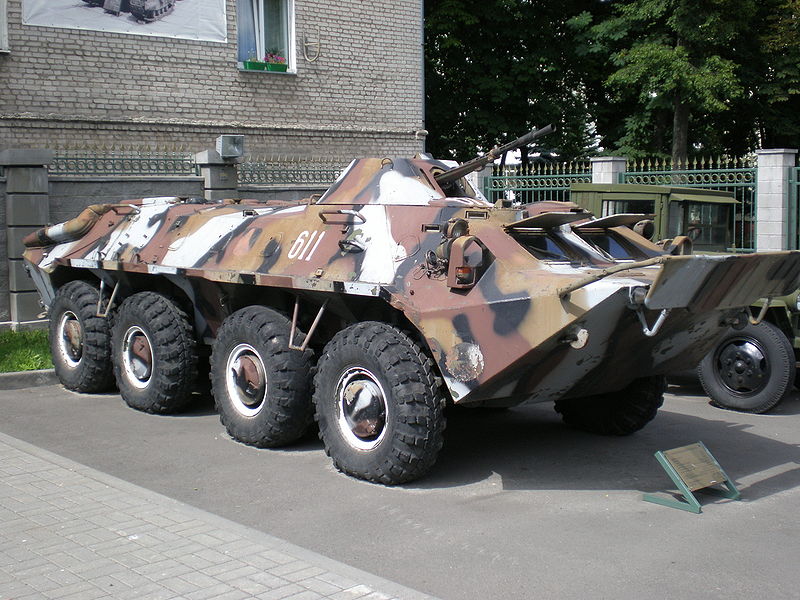
BTR-70 from Belarus, notice the camouflage.
Other equipments
Although the hight roadwheels were supported by the same suspension system than on the BTR-60, 8 torsion bars, suspension arms with between 16 and 12 double-acting hydraulic shock absorbers. In addition there was now a serial central tire-pressure regulation system. This gave the driver the option of adjust the tire-pressure from within the vehicle, according to the softness of the terrain. The tyres were of the 9-18 type with detachable rims. The modified model with central regulation were K-58, 13,00-18 in size.There was also a R-123M radio set and an R-124 intercom. The driver was given three TNPO-115 vision blocks and a TNP-B day vision device, which can be swapped for a TVNO-2B night vision device. The commander also has three TNPO-115s but also a TPKU-2B day/TKN-1S night sight with an OU-3GA-2 passive IR searchlight. The turret is given a PP-61AM/1PZ-2 gunner's periscope while the infantry has access to TNP-B sights. There is no NBC lining but a FVU NBC filter system and a DK-3B fire detection device on board.
Production
Production figures for this model are all but ellusive. Estimation ranges from 5,000 to 8,000. Initially the BTR-70 was produced at the Gorky Automobile Plant. But since 1981, production was moved to the Arzamas auto parts factory and the first vehicle was released in February 23, 1981. The first batch participated in the Moskow pay parade. Small modification occured in 1982 (better engines), 1984 (additional turret persicope) and 1986 (turret side sight and hull's firing ports). The BTR-70V used the turret and sight from the BTR-80 while the BTR-70M was an upgrade for some vehicles to the BTR-80 standard. Since the vehicle was replaced by the BTR-80, after 1990 large stocks of these fall into the export market. Base price for the BTR-70 was around 57,000 dollars. Today Russia only retained 95 vehicle in service with the Naval Infantry, While Ukraine still have more than 1,600 in its inventory, many pending conversions and modernizations for the export market.Soviet & Russian Variants
- BTR-70 obr. 1982: Improved with 120 hp ZMZ-49-05 V-8 engines.
- BTR-70 obr. 1984: Additional TNPT-1 periscope on the turret roof.
- BTR-70 obr. 1986: Periscope on the left side of the turret, four firing ports in the hull roof.
- BTR-70V: Late-production model (1990): BPU-1 turret & 1PZ-2 sight, but no "Tucha" grenade launchers.
- BTR-70M: Modernized version (turret, engine, rear hull section from the BTR-80.
- BTR-70D: Experimental Diesel version (Muromteplovoz), YaMZ-236D 180 hp engine.
- BTR-70D-1/D-2: Improved version with passive IR thermal imagery and intensifier
- BTR-70MS: Turretless long range signal vehicle (100 km) with four radios, switchboard, 20 field telephones, and a 4kW generator.
- SPR-2 "Rtut-B": Electronic warfare variant (detonate artillery shells with proximity fuze detonators). SPR-2M: More compact equipment.
- BTR-70K: Command version. Additional radios with whip antennas, navigation device, portable generator.
- BTR-70Kh: NBC reconnaissance version.
- BTR-70KShM: Command and control version, mobile command post.
- SA-22: (spetsapparatnaya mashina) command vehicle for special operations.
- 15Ya56M MBP: base security vehicle for Strategic Rocket units. New turret, 1PN22M1 sight, loudspeakers, IR searchlights, TNPO-170 periscopes.
Local variants
Ukraine (after 1990)
- BTR-70D (2001) Upgrade by NRMZ: 300 hp diesel engine, BTR-80 hull side escape hatches.
- BTR-70DI: IVECO Euro II 276 hp diesel engine, "Ingul"/"Bug" modular turrets, "Zaslon" active protection system, AGS-30 automatic grenade launcher, 2 AT rockets. Developed for export.
- BTR-70M: Morozov upgrade, 300 hp engine UTD-20, "Grom" or BAU-23x2 turret.
- BTR-70SM: Unarmed ambulance version with a new hull. Two versions.
East Germany
More than 900 were in service after the reunification, according to available data, some 135 were given to Nepal for UN peace keeping operations in Bosnia while 750 others were sold to Pakistan.- SPW 70 (Schützenpanzerwagen 70) 1,316 Romanian-made BTR-70s (1980-1990).
- SPW 70(S): Staff vehicle (2 extra radios, 2/3 whip antennas, slim roof right side telescopic mast).
- SPW 70(SL): Forward air control vehicle (R-809M2 radio, 4 whip antennas).
- SPW 70(Ch): Prototype NBC reconnaissance vehicle
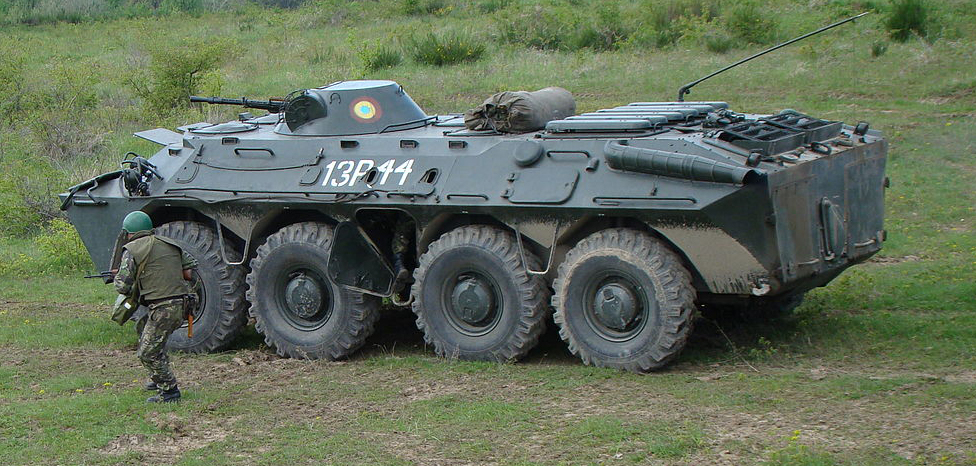 Romanian TAB-77 of the 191th Infantry Batallion.
Romanian TAB-77 of the 191th Infantry Batallion.
Romanian TAB-77
The TAB-77 (transportorul amfibiu blindat) was built under licence for export, but alongside a domestic model was also developed, much improved. It has the same turret with the LOTA aiming system found on the TAB-71 but Saviem 797-05M1 132 hp diesel engines instead of their original powerplant.- TAB-77 M1983 Prototype: 30 mm gun and 9M14M "Malyutka" ATGM.
- TAB-77 M1984 Prototype: 23 mm gun and 9M14M "Malyutka" ATGM.
- TAB-77A PCOMA Artillery command and forward observer vehicle. Single pintle-mounted 7.62 mm machine gun on the hull roof.
- TAB-77A R-1451/M Command vehicle (R-1070, R-1451M radios, additional whip antennas, a rear-mounted generator).
- TAB-77A R-1452 Signals vehicle (R-1452 radio, dummy turret, seven whip antennas, telescopic mast, two generators, pintle-mounted LMG on the hull roof)
- TERA-77L Recovery vehicle (5t crane & dozer blade)
- TABC-79 Short 4x4 developed version
- Chinese TAB-77, license built 13 ton vehicle for evaluation only in the 1980s
Operators
Armenia (20, some upgraded: diesel engine, 23 mm gun), Azerbaijan (57 upgraded with diesel engine, "Şimşek" turret), Belarus (446 vehicles with proposed upgrades like the BTR-70M-A1 and BTR-MK (KM-70) command vehicle and MTP-K (MTP-70) Technical support vehicle), Bosnia-Herzegovina (3), Bangladesh (Around 55), Djibouti (6), Estonia (4, now retired), Georgia (45 including some BTR-70DI with 30mm AGS and 2 AT rockets), Kazakhstan (45), Kyrgyzstan (45), Macedonia (58 SPW 70, SPW 70(S), BTR-70D), Moldova (5), Mongolia (40+), Pakistan (120 BTR-70 & BTR-80), Romania (170 TAB-77), Russia (95), Ukraine (1,026), Uzbekistan (36), Tajikistan (2), Turkmenistan (170), Vietnam (150), Palestine (50). Nepal once used 135 ex-German vehicles by NEPBAT in Bosnia for UN operations.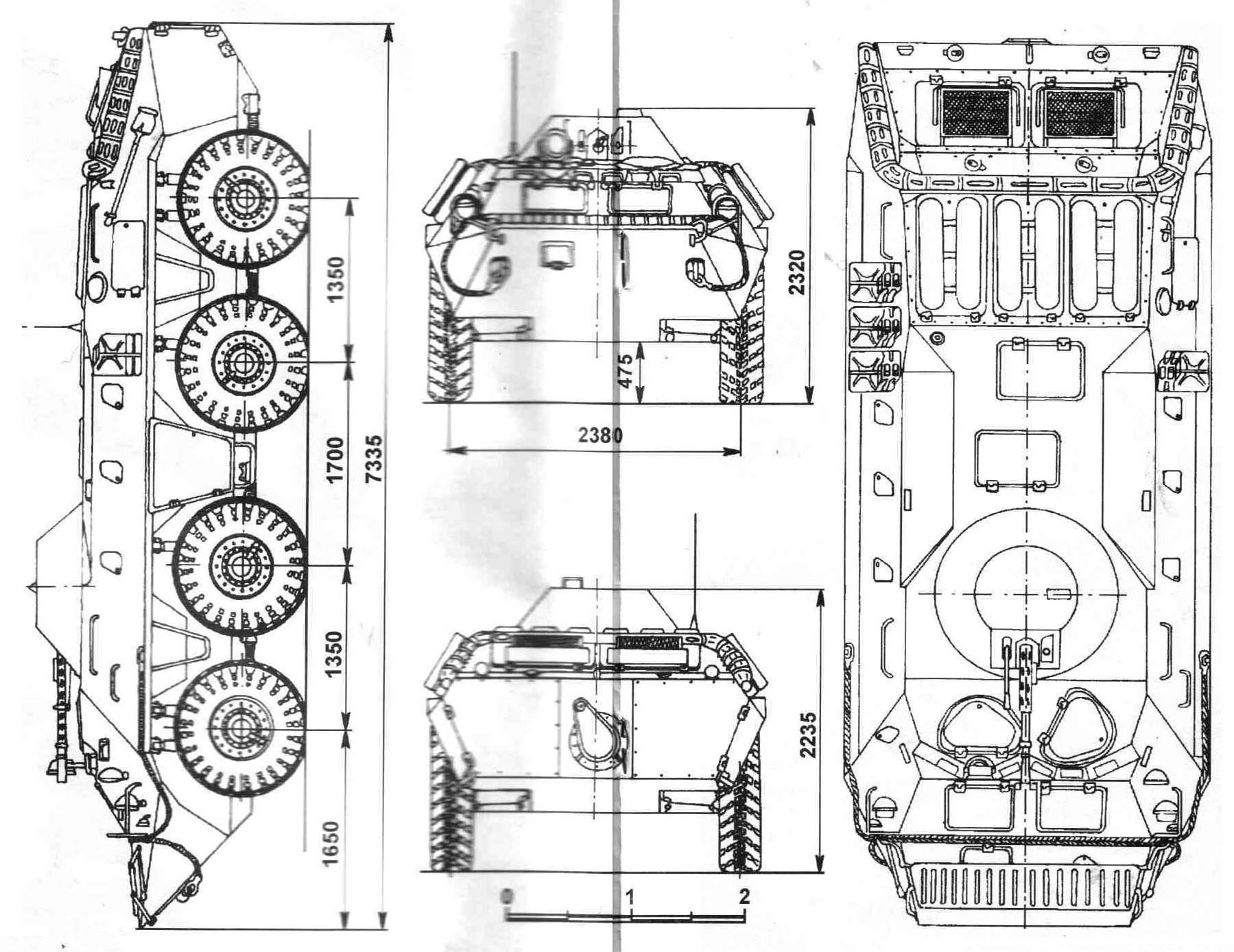
4 view drawing - unknown origin.
The BTR-70 in action
The only known theater of operation for this vehicle in Soviet service was the war in Afghanistan. TAB-77 saw limited action during the Romanian revolution and in Bosnia through peace keeping operations (by Nepalese forces). However in more recent times in 2014, it was used by Ukrainian forces in the Donbass & Donetzk area against Pro-Russian forces and at least one was captured by the militias of the Donetsk People's Republic.BTR-70 related links & resources
The BTR-70 on WikipediaFacts & figures about the The BTR-70 and others BTRs
BTR-70 specifications |
|
| Dimensions (L-w-h) | 7.56(7.85?) x 2.83(2.45?) x 2.31 m (? x 9.28 x 7.58 in) |
| Total weight, battle ready | 11.5 tons |
| Crew | 2+8 |
| Propulsion | 2× GAZ-40P 6-cyl. gas. 180 hp (134 kW) combined P/w ratio 18.4 hp/tonne (13.7 kW/tonne) |
| Top Speed (land/water) | 80 kph(26 mph)/ 10 kph(6.2 mph) |
| Range (road/off road) | 500 km (370 mi) on 290L fuel |
| Armament - see notes | 12.7 mm DsHK or 14.5 KPVT HMG, 1x 7.62 mm KPT MG coax. |
| Armor | 5 to 10 mm (0.2-0.2 in) |
| Total production | Approx. 5000 |
Gallery
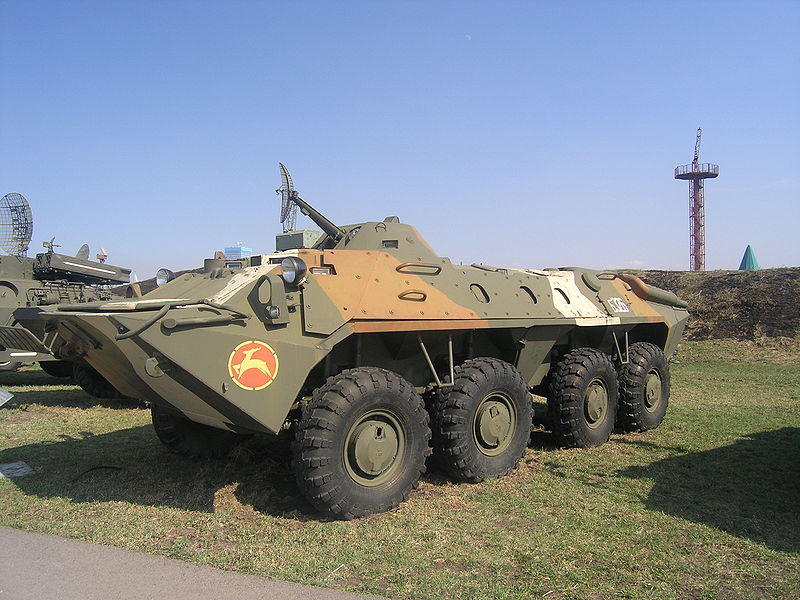
Late up-armoured BTR-70 at Togliatti
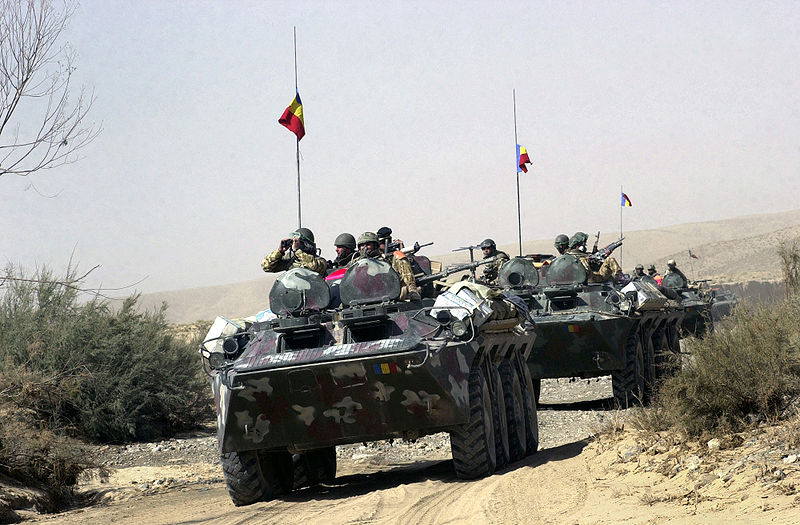
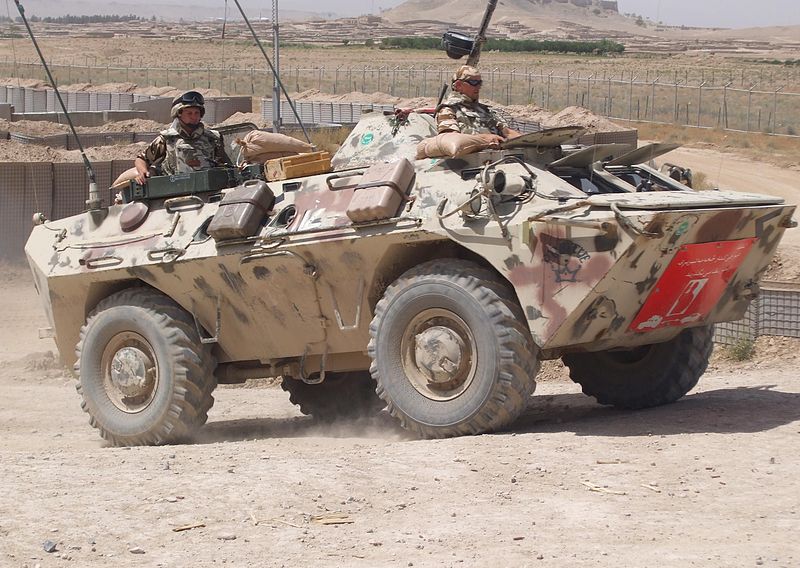
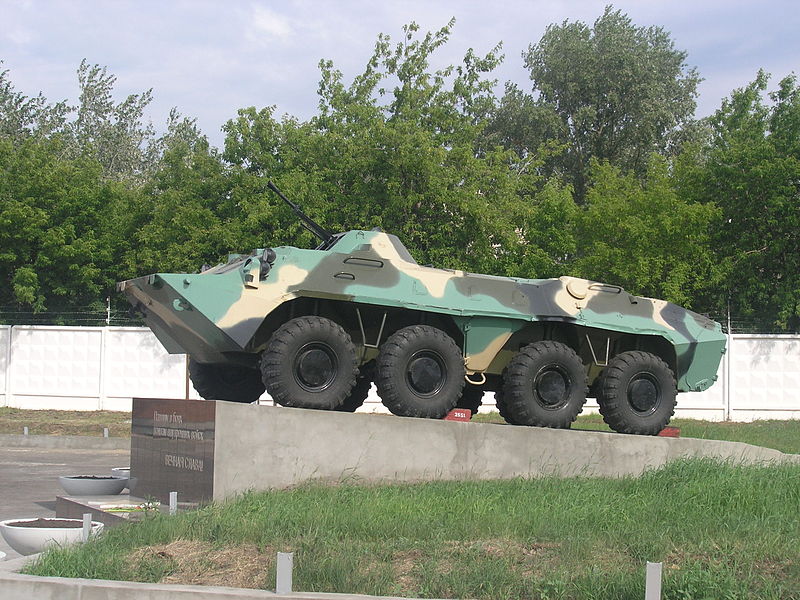
-rear.jpg)
-side.jpg)
.jpg)
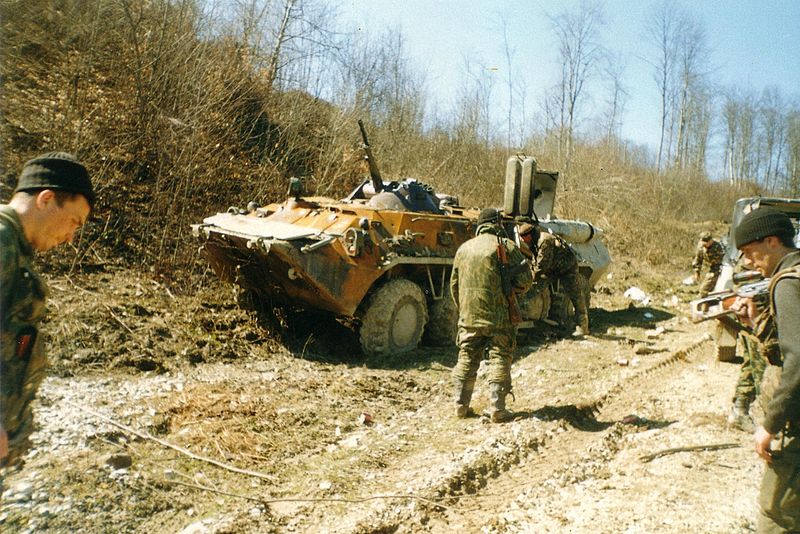
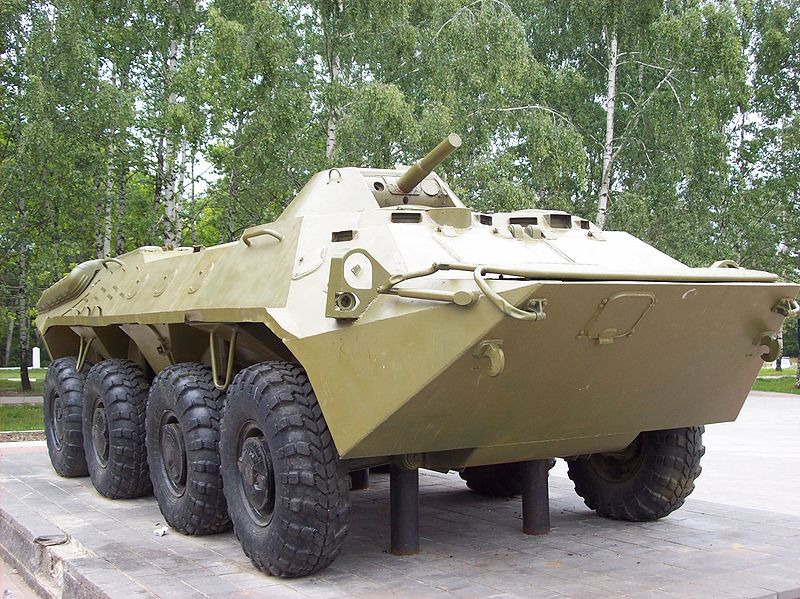
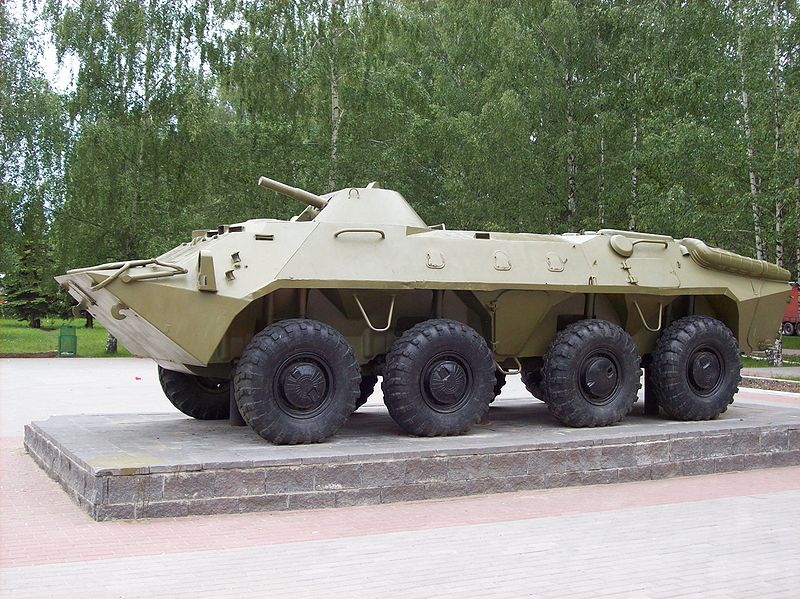
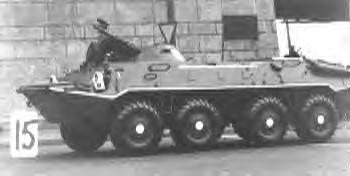
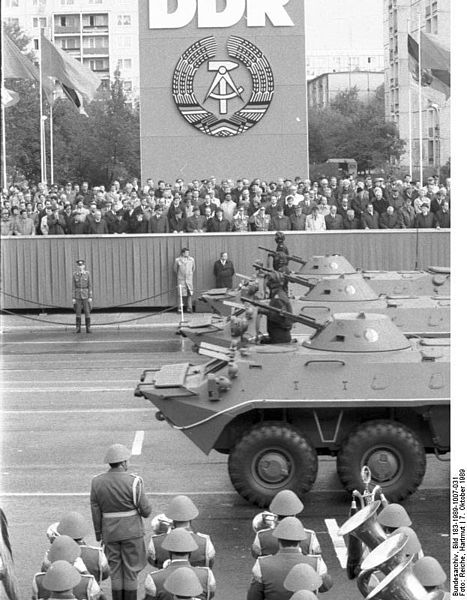
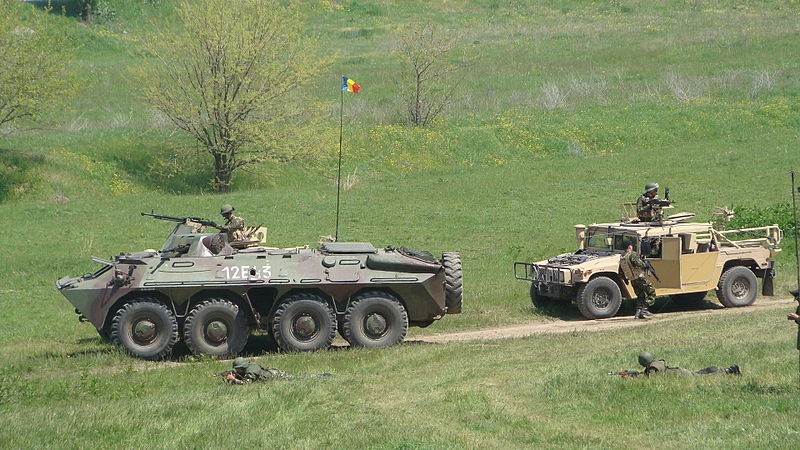
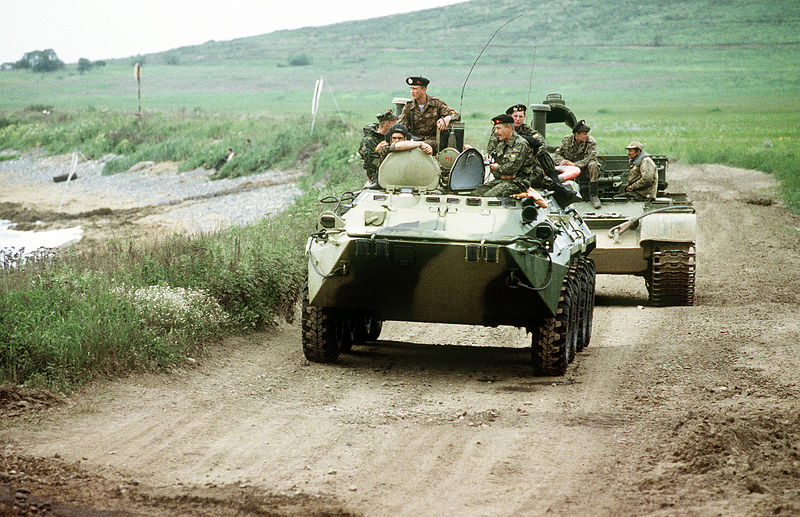
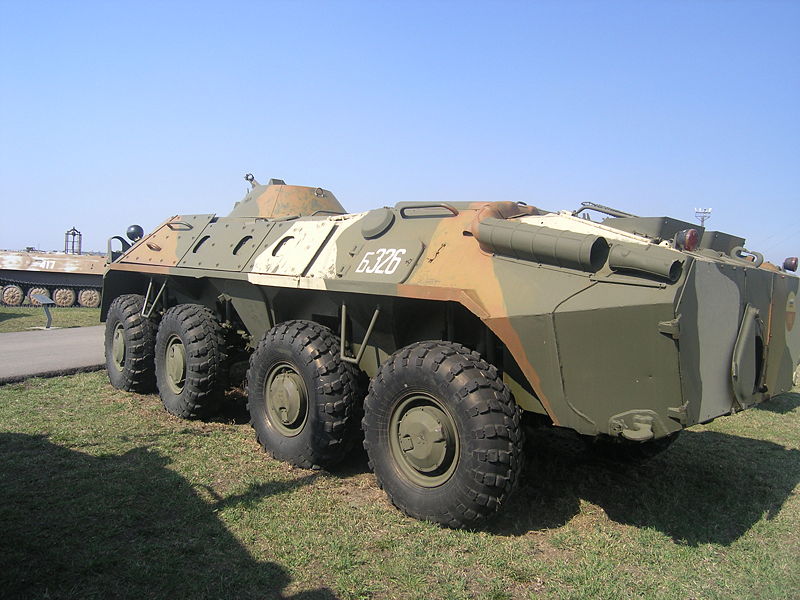
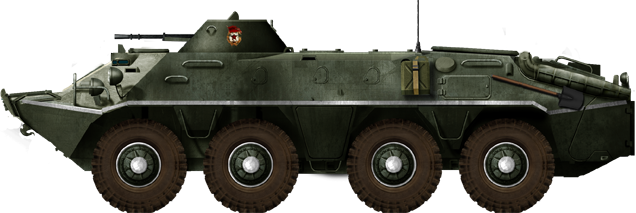
Early production BTR-70, first batch, in May 1981 Moskow parade.
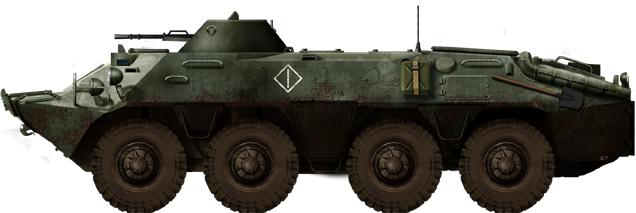
Early BTR-70 obr.84 of the rifle motorized regiment in Afghanistan, 1980-89

BTR-70 Obr. 86 in operations, late 1980s

East German SPZ-70, 24th Mot. Schützenregiment "John Scheer", 4th Mot. Division, Erfurt 1985.
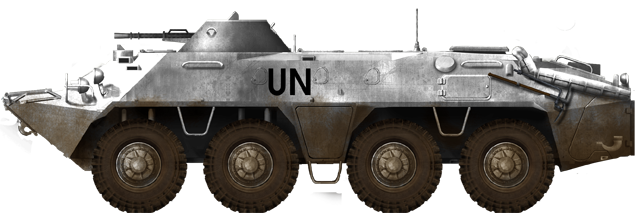
Early BTR-70 in peacekeeping operations, 1990s
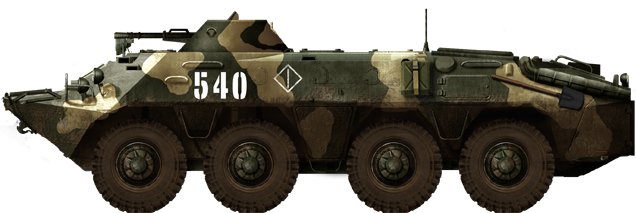
Mid-production type in Afghanistan, 1980-89.
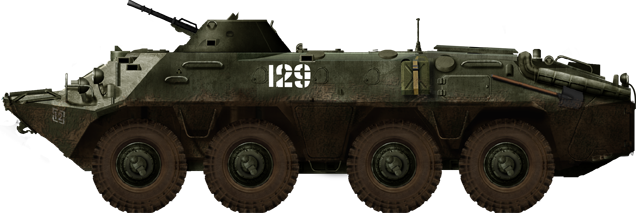
Late type, unkown soviet unit, fall 1980s.

Late type, camouflaged, unknown mot. rifle regiment unit.

East German SPZ-70, late 1980s
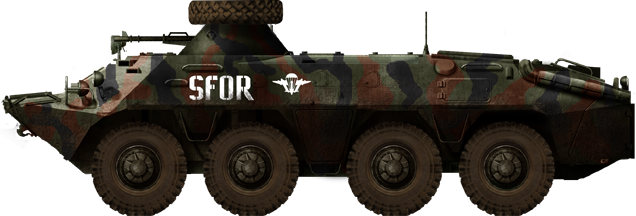
Mid-production type, Ukrainian peackeeping forces in the Balkans, Sarajevo 1995.

Late type, Ukrainian VDV 240 special batallion in peacekeeping operations, Balkans 1995-97.
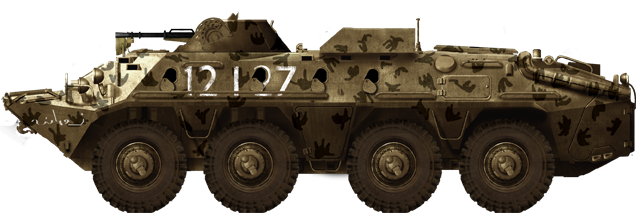
Romanian TAB-77 in Afghanistan, 2007.
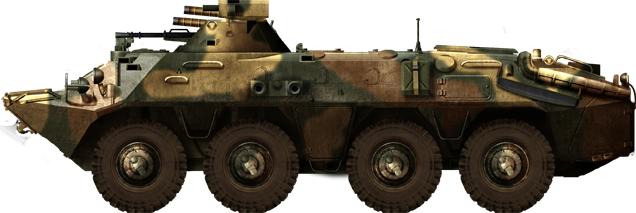
BTR-70D-1 Cobra K, modernized version in Russian service, 1990s.

Cold War Tanks


































Cold war tanks posters

Cold War Main Battle Tanks

Cold War Soviet Army

